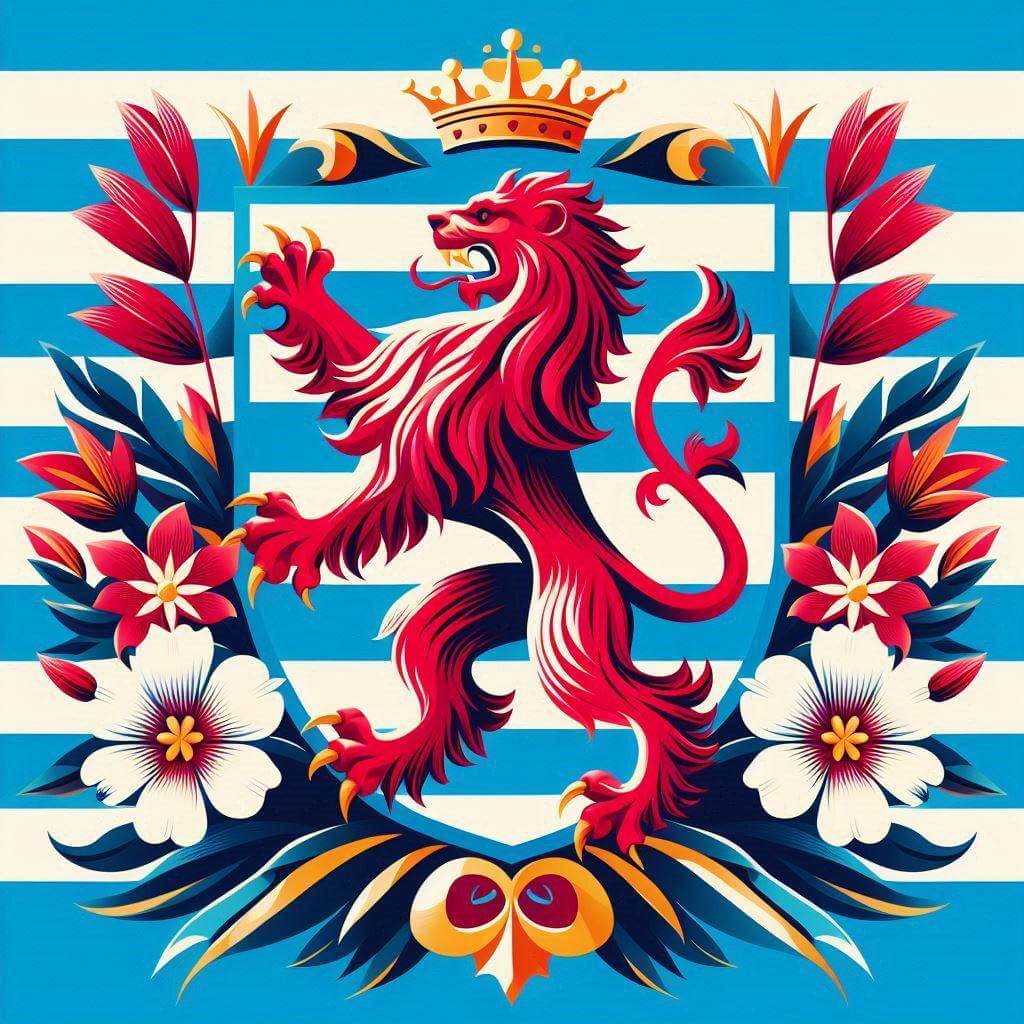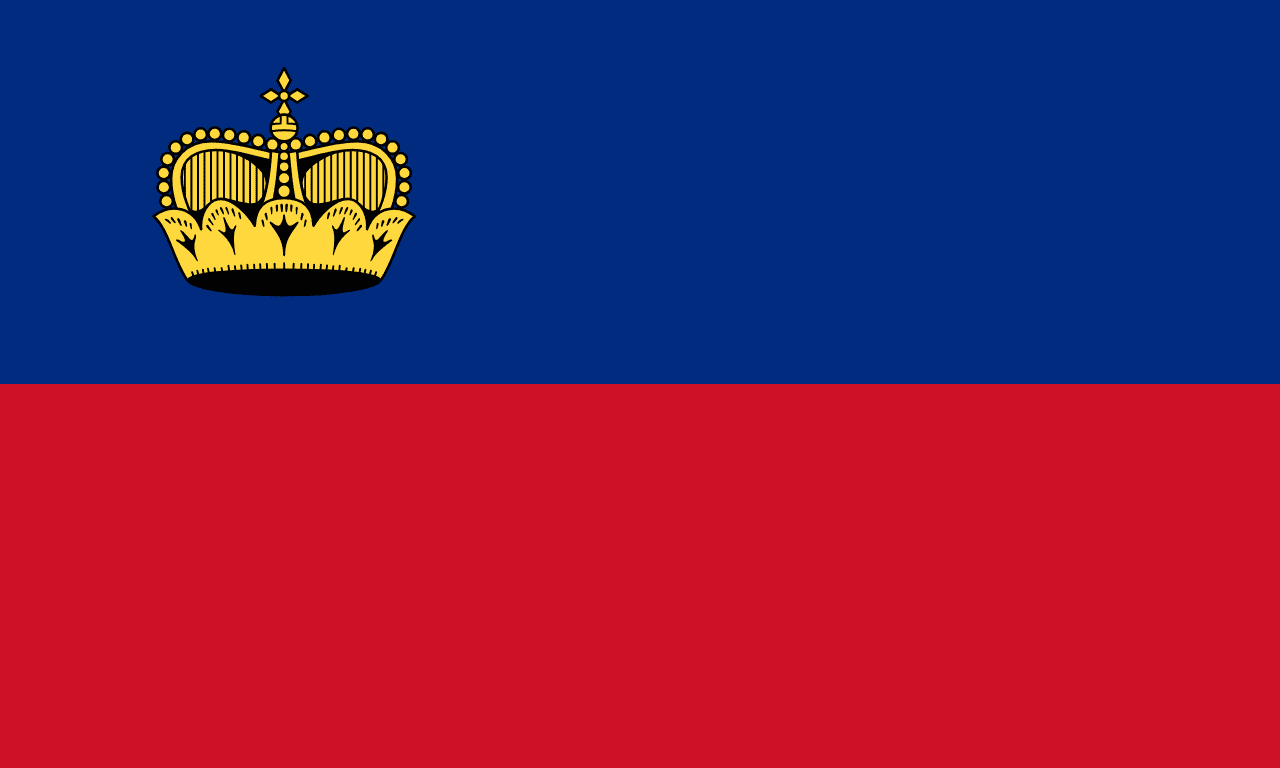La bandera de Luxemburgo consta de tres franjas horizontales: roja en la parte superior, blanca en el medio y azul claro en la parte inferior. Este diseño tricolor, aunque similar a la bandera de los Países Bajos, tiene su propio simbolismo y significados históricos únicos.
Información sobre Luxemburgo
| Día de la Bandera Nacional | 23 de junio |
| Estado soberano | Sí |
| Nombre oficial | Gran Ducado de Luxemburgo |
| Capital | Luxemburgo |
| Población | 590,667 |
| Área | 2,586 km² |
| Moneda | Euro (€) (EUR) |
| Idioma | Luxemburgués, Francés, Alemán |
| Continente | Europa |
| Región | Europa Occidental |
| Subregión | Benelux |
| Fronteras | Bélgica, Francia, Alemania |
| Zona horaria | Hora Central Europea (CET) UTC+1 |
| Código telefónico | +352 |
| Dominio de nivel superior | .lu |
Historia de la bandera de Luxemburgo
 La bandera de Luxemburgo tiene una rica historia que se remonta al período medieval. El diseño actual fue adoptado oficialmente el 23 de junio de 1972, pero sus orígenes se remontan al siglo XIII. Los colores rojo y blanco provienen del escudo de armas de los Condes de Luxemburgo, que presentaba un león rojo sobre un fondo a rayas blanco y azul. La franja azul claro se añadió posteriormente para diferenciar la bandera de la bandera de los Países Bajos. El diseño tricolor ha estado en uso desde la Revolución Belga de 1830, aunque no fue oficialmente codificado hasta 1972. Esta larga historia refleja el viaje de Luxemburgo desde un condado medieval hasta una nación moderna e independiente.
La bandera de Luxemburgo tiene una rica historia que se remonta al período medieval. El diseño actual fue adoptado oficialmente el 23 de junio de 1972, pero sus orígenes se remontan al siglo XIII. Los colores rojo y blanco provienen del escudo de armas de los Condes de Luxemburgo, que presentaba un león rojo sobre un fondo a rayas blanco y azul. La franja azul claro se añadió posteriormente para diferenciar la bandera de la bandera de los Países Bajos. El diseño tricolor ha estado en uso desde la Revolución Belga de 1830, aunque no fue oficialmente codificado hasta 1972. Esta larga historia refleja el viaje de Luxemburgo desde un condado medieval hasta una nación moderna e independiente.
Simbolismo y diseño de la bandera de Luxemburgo
Cada color de la bandera de Luxemburgo tiene un significado simbólico. La franja roja en la parte superior representa el "león rojo" de Luxemburgo y simboliza el poder, el coraje y la sangre derramada por la independencia. También representa el intenso patriotismo del pueblo luxemburgués. La franja blanca en el medio simboliza la paz y la honestidad. Representa la pureza de las intenciones del país y su compromiso con la neutralidad en los asuntos internacionales. La franja azul claro en la parte inferior representa la libertad, la lealtad y la justicia. También simboliza el cielo y los pintorescos ríos Mosela y Sauer que atraviesan Luxemburgo. Juntos, estos colores encarnan el lema nacional de Luxemburgo: "Mir wëlle bleiwe wat mir sinn" (Queremos seguir siendo lo que somos).
Uso y significado de la bandera de Luxemburgo
 La bandera de Luxemburgo es una fuente de orgullo nacional y se exhibe prominentemente en todo el país. Ondean en edificios gubernamentales, escuelas y durante celebraciones nacionales como el Día Nacional (23 de junio). La bandera juega un papel crucial en fomentar la unidad y la identidad entre la diversa población de Luxemburgo, que incluye un número significativo de residentes extranjeros. En contextos internacionales, la bandera representa a Luxemburgo en entornos diplomáticos, reuniones de la Unión Europea, eventos deportivos e intercambios culturales, simbolizando la soberanía del país y su rol como miembro fundador de la UE. Durante tiempos de gran importancia nacional, la bandera sirve como un punto de unión para los luxemburgueses, encarnando su herencia compartida y su compromiso con los valores democráticos.
La bandera de Luxemburgo es una fuente de orgullo nacional y se exhibe prominentemente en todo el país. Ondean en edificios gubernamentales, escuelas y durante celebraciones nacionales como el Día Nacional (23 de junio). La bandera juega un papel crucial en fomentar la unidad y la identidad entre la diversa población de Luxemburgo, que incluye un número significativo de residentes extranjeros. En contextos internacionales, la bandera representa a Luxemburgo en entornos diplomáticos, reuniones de la Unión Europea, eventos deportivos e intercambios culturales, simbolizando la soberanía del país y su rol como miembro fundador de la UE. Durante tiempos de gran importancia nacional, la bandera sirve como un punto de unión para los luxemburgueses, encarnando su herencia compartida y su compromiso con los valores democráticos.
Datos interesantes sobre la bandera de Luxemburgo
- La bandera de Luxemburgo se confunde a menudo con la bandera de los Países Bajos, pero la franja azul de la bandera de Luxemburgo es de un tono más claro (RGB: 0, 161, 222).
- Luxemburgo es el único Gran Ducado soberano que queda en el mundo, un hecho reflejado en la significancia histórica de su bandera.
- El diseño de la bandera está estrechamente relacionado con los colores heráldicos de la Casa de Luxemburgo, mostrando la rica historia medieval del país.
- Durante la Segunda Guerra Mundial, la bandera de Luxemburgo se convirtió en un símbolo de resistencia contra la ocupación nazi.
- Las proporciones de la bandera de Luxemburgo son 1:2 o 3:5, lo que es ligeramente diferente de muchas otras banderas europeas.





